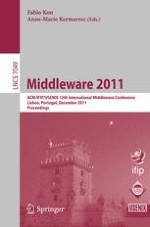This book constitutes the refereed proceedings of the ACM/IFIP/USENIX 12th International Middleware Conference, held in Lisbon, Portugal, in December 2011. The 22 revised full papers presented together with 2 industry papers and an invited paper were carefully reviewed and selected from 125 submissions. The papers are organized in topical sections on social networks, storage and performance management, green computing and resource management, notification and streaming, replication and caching, security and interoperability, and run-time (re)configuration and inspection.
